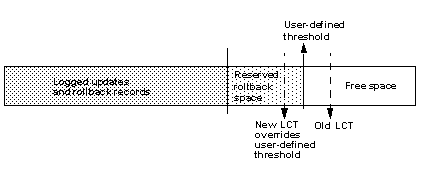Because rollback records occupy extra space in the transaction log, there is less free space after the user-defined threshold for completing a dump than in versions of SAP ASE that do not use rollback records.
However, the loss of space for a dump because of the increased last-chance threshold is likely to be more than compensated for by the space reserved for rollback records for open transactions.
You can use a user-defined threshold to initiate a dump transaction. Set the threshold so there is enough room to complete the dump before the last-chance threshold is reached and all open transactions in the log are suspended.
In databases that use mixed log and data, the last-chance threshold moves dynamically, and its value can be automatically configured to be less than the user-defined threshold. If this happens, the user-defined threshold is disabled, and the last chance threshold fires before the user-defined threshold is reached:
The user-defined threshold is reenabled if you set the value for the last-chance threshold greater than the user-defined threshold (for example, if the last chance threshold is reconfigured for the value of “Old LCT” in the previous image).
In databases that have a separate log segment, the log has a dedicated amount of space and the last-chance threshold is static. The user-defined threshold is not affected by the last-chance threshold.
